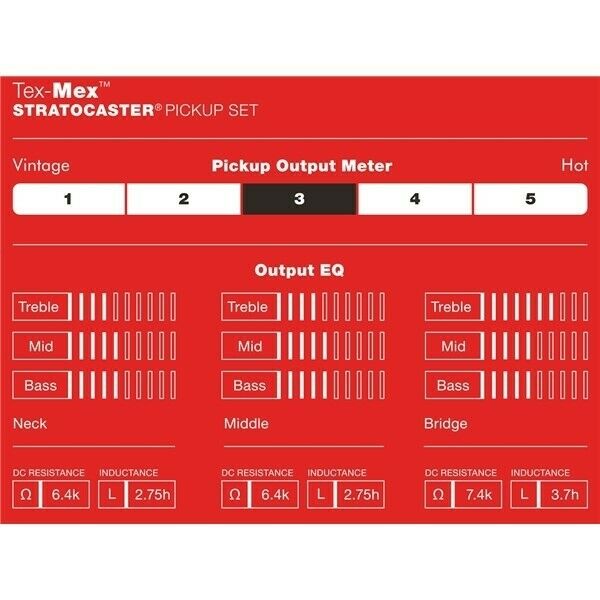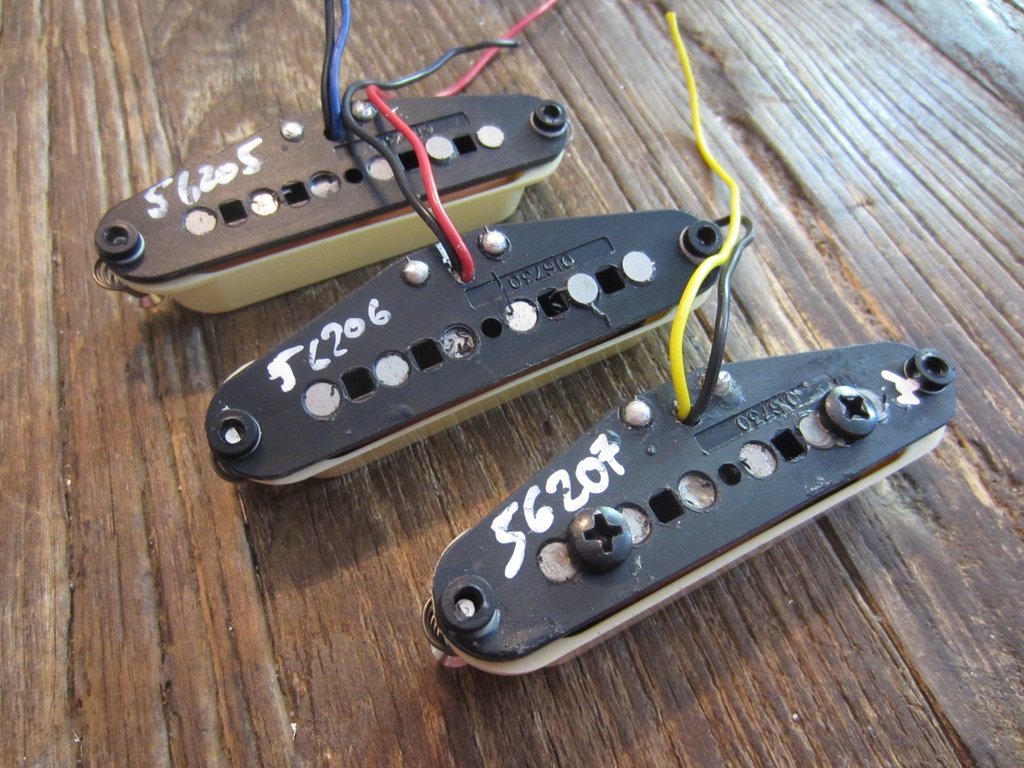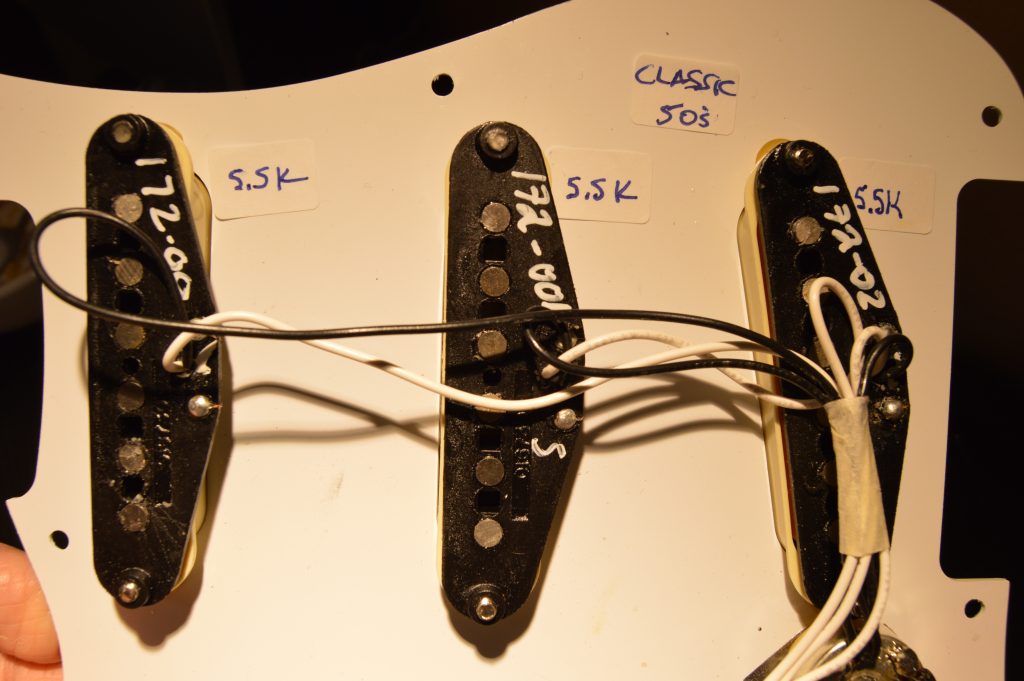Identifying Fender pickups ranges from an easy to a difficult job at times. So far this page covers the newer pickups and not older 50-80s pickups. Dealing with those is a complete game of “it’s overprice, it could be fake, it’s hard to tell” and I just don’t even feel like dealing with that goofy scenario at all, given all the amazing pickups that are available out there.
NOTE: This information is subject to change and I’m updating it all the time as I run into new or conflicting information. More pickups are getting added and the editorial comments are getting updated as I go.
Fender typically has no “set” look for their pickups and often no number scheme or another unique identifier written on the pickup itself. The best way to identify is often by looks and measurements combined.
Some info you should know is:
- The “Number” on the back of the pickup is usually a middle number in the actual part number and this may change over time for the same model of pickup.
- The number that is “molded” into the plastic is a BOBBIN NUMBER and is used over and over in different pickups. That just the plastic part number.
- The resistance values are approx. and can vary up to 5% in some cases or even more so the DCR are a guideline not an absolute.
- Tex Mex
- American Standard
- Highway One
- Player Stratocaster (2018+)
- Made in Mexico Standard
- Pure Vintage 65
- Classic 50s
- Ceramic Squier
- Custom Shop 56
- Custom Shop 54
- Yosemite (Performer)
- Texas Special
SEE NOISELESS PICKUPS (for Noiseless, SCN, N3, N4, Ultra, etc)
Pickup Measurements
See my new REAL MEASUREMENTS Page
TEX-MEX
Description: These are actually quite common but popular “go to” pickup in the Fender line up. Their pricing is slightly more than MIM Ceramics but slightly less than Stock American. They were used on many American Standard Stratocasters as were the Fat 50s. Often these are incorrectly posted as “American” only because they have been released on AM Standard Stratocasters (and other AM models) in the past which causes confusion. Also, sometimes US Pickups are incorrectly marked as Tex Mex for the same reason.
Numbers: I’ve seen lots of pictures but these numbers are the VERY consistent. Because this number is SO common I would rather expect it.
- NECK 50657 (White) – 6.5K – 2.75 H
- MIDDLE 50658 (Red) – 6.4K – 2.75 H
- BRIDGE 50659 (Yellow) – 7.4K – 3.7 H
- Pole pieces are NOT Beveled
- Pole pieces are Staggered (different heights)
- The output frequencies are rather flat for the neck and middle with slightly milder treble, but the treble is accented for the bridge and it’s a bit hotter
- It’s output is average
- These are very popular pickups.




Set Numbers from Box: 0992131000
American Standard
Not the same as American Special and American Performer (2018-2020) but in the same “line”. In fact, it was no uncommon for Fender Stratocaster to come from the same line (I got a American Special that the neck said Highway 1 Line straight from fender). The American Standard pickups are rather tricky because they changed over the years. The y do have some very very common features that are very identifiable. Early American Standard are actually the same as Tex Mex. The American Standard pickups change from time to time and the newest models of “Standard” AM Stratocasters are called the Performer and use different pickups. These are solid pickups. They changed to Fat 50’s for a few years there before the performer came out and started to use Yosemite pickups.
WIRES: Blue/Black (neck) – Red/Black (middle) – Yellow/Black (bridge)
Numbers: (UP TO 2007) 56205 (neck), 56206 (middle),56207 (bridge) — The official Fender document lists them as 0056205000, 0056206000 and 0056207000. (The left handed versions are the same but are 56707 (for example))
Numbers: (AFTER 2007) – White leads changed to BLACK and colored wires are “hot”
Special Features: Some Bridge pickups have SCREWS in them. Those are HOT Bridge pickups and are used in the DELTA release.)

After 2007

Before 2007 –
NOTE: The pickup bobbin is NOT a good identifier because Fender used that bobbin on many different pickups.
Measured: American Standard Pickups – clock in at a 6-6.1K DCR
HIGHWAY 1 (2001-2005)
Highway 1 has had different pickups through the years, the early one had lower value pickups that are very unusually wired from finish to start instead of start to finish!! Often they are still connected with white “HOT” when they are actually “Black” Hot. The later ones are start to finish as expected.
The wires are all Black and White. The DCR for them is about DCR: 5.8K-6.1K; the same as the American Standard and the neck and bridge are can be the same. There appears to be a lot of variance on the DCR which no values having a dominate value. There are NO identifiable marks on them except the typical bobbin number. The poles are FLAT (not beveled) and very Staggered. More vintage tone than the later ones.
- Staggered
- Not Beveled
- Black and White (with White as the start – ie: Black is “Hot”)
- Early ones have a much lower DCR (around 6K ish, later ones are much hotter
- Early ones have more Vintage Tone.


LATER HIGHWAY ONE PICKUPS (roughly 2005 on till the AM Special came out in 2011)
Some later Highway 1 Strats have number on them 72706, 72707, 72078 then came later in the 2000’s and the DCR was crazy high and can have a wide tolerance range (about 1.5K variation). Very unusual for AM stock pickups. These are ANICO 3. ALSO they are NOT Staggered. Further, they have colored wires on the as shown below. Not vintage tones at all.
- Lots of variance of DCR, from about 10.6K to 12.1K
- Center pickup has Red and Black
- Normal start and finish (black is start and “ground”)
- Not Staggered
- Alnico 3
One of them: Neck – 11.13k Middle – 12.13kBridge – 12.01k
Another one: Neck 10.6 K, Middle 11.7 K, Bridge 11.7 K


Fender Player Stratocaster (2018ish+)
This is Fenders MIM replacement for the older Fender Standard Stratocaster (MIM). The bottoms of these pickups look a LOT like an American Standard they lost the old “2 magnet” ceramic look and use Anico 5 pole pieces. One EASY to spot different it red marks on ALL of the pole pieces.
They are very good pickups, fairly hot and slightly smoother than the Ceramic version. Not that there is anything wrong with the old ceramics, they are great but these are better overall IMHO (unless the ceramics are wiring in with dual coil arrangements then they can be pretty killer).

- Beveled
- Staggered
- Anico 5
- Red Mark on the bottom of each pole piece make them easier to identify.
- Numbers: 131, 132, 133 (neck to bridge)
- Wires: White, Yellow, Red (Bridge) with Black as the ground (Start)


HSS VERSION
Fender Standard Stratocaster (MIM) – late 90s to about 2018
Fender Standard Stratocaster (Made In Mexico) have had the same pickups for a LONG time until 2018. They are very easy to recognize by their two ceramic bar magnets on the end and some other features. These puppies are not remagnetizable like the “pole” magnets of the American Standard or player because it uses Steel pole pieces and the magnets supply the field. Another thing to note is that SQUIER has pickups (for their line) that look VERY Similar to these pickups and have 2 magnets on them also, but they measure in about 1/2 the DCR of these MIM versions and have flat “pole” pieces with a swirl on top. They almost sound Vintage where the MIM ones are much hotter and “raw” sounding. See Squire Ceramics
- Non Staggered Pole Pieces
- Not Beveled
- Steel pole pieces with Ceramic Magnets (2)
- White/Black wires except for middle which is Yellow/Black if it’s reverse wound. (CCW)
Look for the Yellow reverse wound pickups for the center pickup (bucks hum on position 2 and 4)
Squier Lookalikes: They have a very distingishable top swirl on their non stagged poles. They are lower output vintage sounding (see below) and not as hot as the MIM and sell for about 25%-40% less. However, and a big one, with the right wiring options, they are just fine and they play really well with Bruce’s Dual Stratbucker circuit. Also the low output works great with Pedals.
Wires: White/Black (neck) – Yellow/Black (Middle) – White/Black(Bridge) MIMs


OTHER
Am. series or standards-plastic flatware. Mid 80’s and up (Standard NAMM intro 1987 TBX) to the delta tone, red middle pup wire, blue neck and bridge- whites to the switch.
Classic Series 60’s – Alnico V, all black and white wires, DCR around 5.6 KΩ
Classic Series 70’s (acually are pre 2006 upgrade Highway One pups) – all black and white wires A III mags, 6 KΩ
Pure Vintage 65
Good Pickups. These are sold after market and not included in any stock Stratocaster.
- DCR: 5.9K to 6K
- Enamel Wire (darker)
- Staggered
- Gray Bottom (always)
- Higher Output with more bottom less treble
- Available: Still available 2021
This guys sound fine with IMHO the neck pickup sounding the best. With the Mid Bucker circuit this guys are the bomb. The bridge pickup LOVES Pedals.


CLASSIC 50’s
These are MIM pickups and sound quite good. They are about 5.5K but vary about 5% or so between batches, meaning, that chances are the 3 that you get are pretty close to each other, but in other batch they may be a little different in OHM readings. But only about 5% diff that I can tell which is quite accurate.
- DCR: About 5.5K
- Staggered Poles
- Stock they have off white pickup covers.
- 172-000 (neck), 172-001 (middle), 172-002 (bridge)
- All White Black Wires
- Consistent Numbering


Squier Ceramics
Fender Squier has many pickups but there are a few I really want to comment on. The first is their Ceramic. These guys will REALLY surprise you. Their have a reading about a little over 1/2 DCR of the MIM ceramics but they sound like nice vintage pickups. It’s the only Squier pickup I personally like. I don’t believe they make these anymore and used to be found on many different version but mostly the affinity. They were on Korean made Fender Strats years ago also. With a value of roughly HALF of the value of the MIM counterpart (about 3.7K) means but their output is much lower and they almost sound like a vintage pickup with crisp and clear response. I rather like them for what they are and with a series arrangement they really rock. This is my favorite Squier pickup. Note the the middle one has a yellow lead, and it is reverse wound to cancel hum in positions 2 and 4, nice.
- Some have a number label on them
- They measure around 3.7K (1/2 of the MIM Counterpart)
- 2 Ceramic Magnets with Steel pole pieces
- Swirls on top of the pole pieces
- Slight Bevel
- Mild Stagger
- Very good for Vintage sounds and when used with a boost pedal (or mild compressor) they are very good
- Lower output not for everyone
They are easy to identify because the top of the poles are NOT staggered and they have a swirl on the top unlike the MIM versions have no swirl and are slightly beveled.
Finally some of them have a sticker with a number of them, I haven’t researched that. But since they are so easy to identify with DCR that it really doesn’t matter. Import pickups usually use a SINGLE bar magnet so it easy to identify this as a Squier pickup.




OTHER SQUIER PICKUPS
There are lots of other Squier pickups. I will not use any of the single magnet version out there. They just don’t produce sonically enough to work with (unlike the ceramics which love the Dual Stratbucker circuit). And on top of that, they have a very low market perception so they are a “no fly zone” for me. This is what they look like in general.
Also, other Squier pickups can be gotten that don’t have the magnet on the bottom like this and are Anico, etc. I just don’t mess with those either. If someone gave me a set I’d play around with them. However, there are too many other good pickups that can be used to make it worth my time to invest energy into them.


VINTAGE 56
I’ve never used these pickups or have been able to get my hands on them so I can’t comment on their sound and output. However, Due to the reading and Anico 3 I would not expect them to be high output and probably sound in line with the 54 and 59 pickups.
- ANICO 3
- FORMVAR wire
- 5.8K, 2.6 H – All pickups the same –
- No Bevel
- Staggered
- No reverse wound middle
Numbers: VINTAGE 56: 099-2235-000 (part number) they said 56 on the back usually.


CUSTOM SHOP 54
FENDER CUSTOM SHOP CUSTOM ’54
I have worked with these, and they are good pickups. Definitely “vintage” sounding. The Bridge is slightly hotter. More detail later. They have cloth wire, which is what they used at the time.
DC resistance:
- Bridge: 6.5k (advertised), 6.43k (measured)
- Middle: 5.9k (advertised), 6.21k (measured)
- Neck: 5.9k (advertised), 6.05k (measured)


YOSEMITE
These were released on the original Performer Stratocasters. They are unusual in that the use Anico II and Alnico 4. They were kind of a first run for the “Tim Shaw” series. Slightly hotter as you move to the bridge. They have more variance between the position that some of the vintage series which use the same pickup for each position. These always read slightly higher than the advertised value.
- 8.1k (neck) – Advertised: 7.8K
- 8.8K (middle) – Advertised: 8.5K
- 9.2K (bridge) – Advertised: 8.9K
- Wires: Neck (Black White), Middle (Yellow Black) Reverse Wound, Bridge (Red Black)
- Available NOS
- Roughly $129 or more New and around $110 used.
$129 New



Texas Specials
Texas Special Pickups are very popular. It’s interesting that the Neck and Mid are ALMOST the same curve but different resonant frequencies. The Bridge has a much higher Inductance and much strong bass response. I actually like that and can see why that’s popular. The middle pickup is reverse wound.
Description: No Bevel, Staggered, Cloth Wire, AlNiCo 5, Enamel Wire, Reverse Wound Middle Pickup with yellow hot lead.
- Output: 4 out of 5
- Neck: DCR: 6.2K Induct: 2.4h – 4/6/8
- Middle: DCR 6.5K Induct 2.6h – 4/6/7
- Bridge: DCR 6.7K Induct 3.6h – 8/6/7
Other: The back of the pickups always have a custom shop sticker unless it was removed.
Identifying: The back has No Dot, Blue Dot and Red Dot on the A Pole. Measuring will tell you which is which but from all the pickguard pictures I’ve seen of these the Blue = Neck, No Dot = Middle and Red = Bridge. Also, the MIDDLE pickup wire is slightly yellow looking.




V-MOD
V-MOD pickups are Tim Shaw designed (you know him right? oh, well anyway) they were released on the first PROFESSIONAL series Stratocaster. The are actually really good pickups
Identifying marks: Red lines through the different poles on the bottoms. Red/Blue/White Hot wires – Beveled and Staggered Poles. The bottom is Blackl.
Some info: Magnet types: Neck: Alnico 3 and 2; Middle: Alnico 5 and 2, Bridge: Alnico 5 beveled, staggered –
Inductance: Neck: 2.76 Henries, middle: 2.74 Henries, bridge: 2.8 Henries
- Type:Single-coil
- Active/Passive:Passive
- Magnet Material:Alnico II, III, V
- DC Resistance:6.7k (bridge), 6.7k (middle), 6.4k (neck)
- Covering:Aged White, Covered
- Manufacturer Part Number:0992266000
- Response: Neck (5,5,5) – Middle (5,5,6) – Bridge (5,5,7) – (Bass, Mid, Treble)
- Power Output: 3 out of 5
- Came on Fender Professional Stratocaster
- Retail: $159 to $199 (full retail) – Used: typical $115 +/- range depending on condition.
- Available: NOS and Used




This is a really cool chart for the V-MODs

V-MOD II
I know very little about this pickups yet except for the following:
- V-Mod II Stratocaster single-coil pickups
- Double Tap bridge pickup
- Came on Professional II Stratocaster
- Availability: Used very rarely, not available in the shop, only on a released Stratocaster.
- (Values up adjusted slightly by .1K because, measured with volume on full) Bridge 6.3K, Middle 6.4K, Neck 6.7K
- Bevelled
- Staggered
- Mix of Magnetic Types: Alnico 3,4 and 5
- For HSS the humbucker is a Dual Tap


